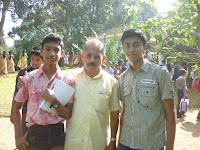









URI MEMBERS VISITED
PALODU BOTANIC GARDEN AND RESEARCH INSTITUTE
URI Keral Region members visited PaloduBotanickal Garden and Vellanad MithraNikathan on 10th December,2011. The study team includes 61 members. Dr. Abraham Karickom, Executive Director inaugurated the study tour. Prof. John Kurakar, Director,Kerala Kavya Kala Sahithy welcomed the team members. The team visited Trphical Botanical Garden and Vellanad Mithra Nikathan, the rural University.The Tropical Botanic Garden and Research Institute (TBGRI), Palode, organized an open house for the public in its campus from December 6 to 10. The open house to provide the public an opportunity to know the research activities at the institute. The garden is one of the largest conservatory gardens in Asia with over 50,000 plants belonging to 3,500 species. Speaker G Karthikeyan will officially rename the institute as Jawaharlal Nehru Tropical Botanical Garden at the inaugural function.
The Scientist of the Botanic Garden Mr Cheriyan P. Koshy said that the aim of the initiative was to create awareness among the public on the institute’s activities. Visitors can also buy a variety of plant species ranging from flower plants, including rare orchids, to tissue culture plantains at subsidised rates. A gnarled vine snaking up the trunk of a host tree represents a success story for the Jawaharlal Nehru Tropical Botanic Garden and Research Institute at.. The creeper, belonging to the Coscinium fenestratum species, a key ingredient in over 60 Ayurvedic preparations for various ailments including eye diseases, is brought back from the brink of extinction. Time was running out for it till 1984 when the institute took up an ambitious conservation project for the species, confined to its natural habitat in the interior forest and endangered by over-exploitation. After several attempts, scientists managed to germinate seeds of the climber, known as maramanjal (tree turmeric) in local parlance for the dark yellow flesh of its stem. Today, the institute regularly supplies saplings of the species to the Forest Department for reintroduction into the wild.
The 27-year-old climber is just one of the attractions in the sprawling 300-acre campus that is home to a bewildering diversity of flora. For five days from Tuesday, the institute is keeping its doors open to the public, under an outreach programme to showcase its rich biological wealth and its research achievements. From the largest collection of bamboos in India, to a carefully recreated homestead medicinal plant garden, giant water lilies floating in a pond, rare orchids, palms, ferns, trees, and tissue culture plants, the Open House had something to capture the interest of every visitor. Everyone of the over 4,000 species on display had name boards for identification.
Stalls exhibiting the research activities and achievements of the various divisions at the institute witnessed a heavy rush. An art and photo exhibition and display of different types of thatching, traditional farming equipment such as yoke, plough and paddle, fish trap, coconut leaf baskets, vetiver fans, wooden boxes, combs, kitchen utensils, and bamboo ladders were the major attractions.
Collection of seeds is another highlight of the event. The double-coconut seed weighing up to 17 kg that is endemic to the Seychelles and the wild durian (Cullenia exarillata) eaten by the lion-tailed macaque inhabiting the Silent Valley forest were instant hits with students.Another interesting highlight is the lady's slipper orchid, a variety that was believed to be extinct until it was rediscovered in the early 90s. The institute is engaged in efforts to propagate the species and reintroduce it in the wild. The traditional homestead medicinal plant garden with its emphasis on conservation education is also a big draw. Visitors thronged the grounds to see various species of carnivorous plants and the country's richest collection of 68 bamboo species. The sales counter set up on the campus sold ornamental plants, fruit tree saplings, and medicinal herbs worth over Rs.20, 000
The URI Team conducted a seminar at Mitra Nikathen open auditorium at 2 30 pm. Mr Viswanathan, Director,Mithra Nikathan inaugurated the Seimar. Prof John Kurakar welcomed and Dr. Abraham Karickom gave introductory speech. There was also a seminar at Peoples College. Mr Sabith, Teacher, Peoples College took leader ship of the seminar there. The team then visited Agriculture Research center,Peoples Library, Small scale industries etc. 61 members participated the study programme. URI Members visited Palod Botanical Garden& Vellanad MithraNikathan on 10th December,2011.Name of participants: Tim Reji, Ephraim, Shyny.P, Cissy, Anila, Mini, Akhil, Nidhin, Rinu, George, Sanoop, Gokul, Boves, Febin, Issac, Angela, Varsha, Linju, Nancy,Nikhil, Jithin, Naison, Smithin, Ashish, Christy, Usha Rajan,Prijit, Reshama, Mihala, Ruby Baby,Mariamma Mathew, Reja Kuriakos, Lincy, Santra, Smitha, Robin Mathew, Rejil Raju, Shibin Baby, Alan Kurian, Jayashree, Molly Kurakar, Anne Thomas Saly George, P.K Varghese, Nihil, Manu, G. Balakrishnan Nair, Alan Babu John Alex Babu John, John Kurakar, Raju.P,Cheriyan.P.Koshy, Y. Johnson, Lilly Kutty, Shibu Thomas,Roshin Shibu thomas, Samuel Nellikkadu, Dr. Abraham Karickom, Dhanya langi, Susan Abraham. P.K Varghese.
Prof. John Kurakar

